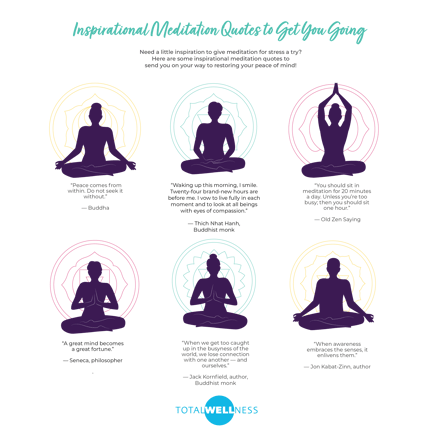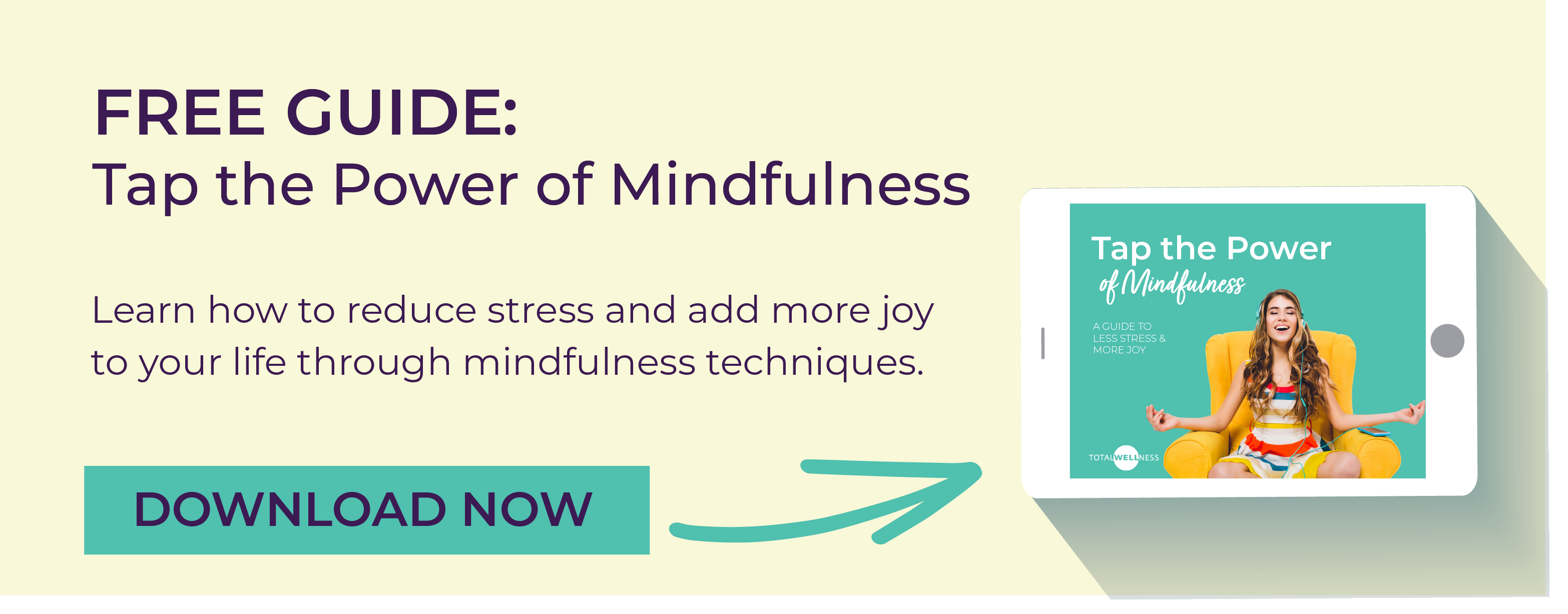 Have you or your employees tried meditation for stress?
Have you or your employees tried meditation for stress?
If not, there’s no better time than now.
With stress and anxiety in workplaces at an all-time high, leadership can step in and offer tools — like meditation — to help quell the stress during these tricky times.
Stress is one of the top causes of illness in the workplace, according to the Chartered Institute for Personnel and Development (CIPD). Too much stress for too long isn’t good for your workers or your workplace. It can cause tension headaches, chronic pain, and even fracture work relationships.
While there are tons of techniques out there for stress reduction, meditation for stress may be the most fast-acting one.
In as little as 10 minutes, a meditation practice can reduce anxiety and stress. It can also help individuals feel relaxed even in the most stressful of situations. Whether working from home or working in an office, all employees can benefit from meditation.
Ready to help your workers feel cool, calm, and collected?
Below we share about meditation for stress benefits, plus simple techniques that can be used starting today by you and your employees.
What is Meditation?
Meditation is a mind-body practice where individuals use a technique to bring attention and awareness to the present moment. This can include techniques such as mindfulness or focusing the mind on a thought or activity. Doing so can bring about feelings of clarity and restore calmness.
Meditation won’t make all stress go away, but it can help individuals better manage it.
The Benefits of Practicing Meditation for Stress
The beauty of meditation is that it offers positive impacts quickly. With just eight weeks of regular practice, individuals can notice a difference in stress reduction. Best of all, it can be done anywhere — on a commute, during a walk, or at any moment during the day when stress starts to creep up.
Research shows meditation can benefit both physical and mental health. Here’s a look at both ways it benefits people:
Physical Benefits
● Better sleep
● Improved memory
● May reduce heart disease risk
● Strengthens the immune system
Emotional and Mental Benefits
- Provides clarity
- Increases creativity
- Focuses on the present
- Enhances self-awareness
- Improves self-acceptance
- Reduces negative emotions
- Increases patience and tolerance
Some research is also uncovering the possibility that meditation may help people manage certain symptoms of health issues like anxiety, asthma, cancer, chronic pain, depression, heart disease, tension headaches, and even high blood pressure.
Types of Meditation
Since meditation is a deeply personal experience and practice, there is not a one-size-fits-all option. Individuals who are looking to explore meditation have the opportunity to try a variety of meditation styles. Some are simple, and other practices may feel a bit more involved.
Here’s a look at a few of the different types:
- Guided meditation - For visual and creative learners, this can be especially relaxing and helpful. Sometimes called guided imagery or visualization, during this type of meditation, you may listen to an audio recording of a meditation teacher speaking.
- Mindfulness meditation - This type of meditation can allow you to become mindful even when you aren't meditating. When your attention wanders, return to the moment through your breath — without judgment.
- Mantra meditation - This style is simple in that you silently repeat a calming word or phrase to minimize and prevent distracting thoughts. This is an easy one to do in a stressful meeting or while you’re sitting in a traffic jam.
- Body scan - Simply lie down or sit in a comfortable position. This mediation style allows you to scan your body from the top of your head to the tips of your toes, acknowledging feelings of discomfort or other bodily sensations.
- Yoga - Some individuals may consider their yoga practice to be their mediation practice, too. Because of the deep concentration on breathwork, stretching, and the present moment, it’s a great way to combine both exercise and meditation.
- Loving-kindness meditation - For individuals who are hard on themselves — AKA perfectionists — a loving-kindness meditation may be helpful. This is a traditional meditation that can increase compassion toward oneself and other people.
There are plenty of other types of meditations. The type to choose should be one that resonates with a particular individual. The key with meditation is consistency — whether that’s for five minutes a day or an hour a day! Just pick a method and stick with it for the best results.
Motivate Your Workers to Look at Meditation for Stress Relief
In 2018, a study by Headspace, the guided meditation app, found workers who used the app for eight weeks straight had a 31% reduction in negative feelings and a 46% decrease in distress. Additionally, a 2016 Harvard study found meditation’s benefits last even longer than a vacation when it comes to stress reduction.
If you’re interested in trying out meditation in the workplace — whether remotely or in-house — it’s a lot easier than you might think. You don’t even need to bring in a meditation teacher to coach your employees.
Below are a few ways to encourage employees to look into meditation for stress relief.
Daily Ways to Practice Meditation
- Journal - Taking pen to paper is a great way to uncover insight, clarity, and raise self-awareness. A daily journaling practice can reduce anxiety, depression, and help individuals feel happier. Topics to try journaling on may include: “Today I’m grateful for…” or “If I had no fear I would…” or “My next best action is…”
- Do a traditional practice - The aforementioned techniques — like yoga and guided meditations — are more traditional practices of meditation. If you want to give it a try, consider trying one method for a week at a time to see which style resonates best with you. Stick with your favorite.
- Exercise and meditate - When you can learn to harmonize both the body and mind, it can become your go-to stress-reducing behavior. Mindful exercise is a great way to do this, especially when you’re taking the time to notice what’s around you, how you’re feeling, and checking in with your emotional “thermometer” for the day.
- Share intentions with colleagues - Before a meeting, consider sharing your intentions for the day. This ritual will allow you to connect more deeply with your colleagues. Positive intentions are a great way to start the day!
- Breathe together - Before any meeting — whether in-person or on a Zoom call — consider taking a few minutes to take a few deep breaths together. The meeting leader can dim the lights, turn on soothing music, or just ask everyone to close their eyes for a few minutes and breathe. This can reset the mind and body before diving into the day’s work.
Meditation is for Everyone Open to Trying It
Meditation doesn’t need to be hard.
Best of all, it’s free and available for anyone of any age to give it a try.
It can be quite easy and routine once you and your employees find the method that best suits personal lifestyles, attention spans, and personal needs. Meditation can reduce stress on both the mind and body, creating a positive domino effect on individuals and their output in the workplace.
Reducing stress in the workplace may not come easily, but it can be done. Meditation is one avenue to try.
Introduce it naturally by:
- Sharing content - Share with employees any new or interesting articles on meditation or mindfulness. By providing reading material, it allows workers to explore it at their own pace.
- Practicing it - Invite employees to join you in a daily meditation event. Whether it’s a walk outdoors, breathwork before a meeting, or a gathering to practice meditation.
- Reminding gently - Hang up fliers around the office with cheerful messages like “Just Breathe” or send a once a day email with a reminder to focus on the breath.
Through meditation, your employees can strengthen their mind, body, spirit, decision-making abilities, and beyond. Research proves it, but it’s up to your employees to give it a try.
Ready to increase the positive vibes in your workplace? Check out our free guide: The Power of Positivity at Work!



